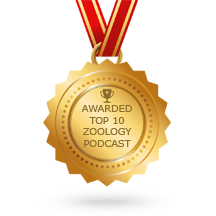Episode 11: Sexual selection in the fossil record
Sexual selection is the process whereby anatomical features are selected because they enhance the chance of an individual’s mating or fertilisation success. Sexual selection is responsible for much of the astounding diversity in morphology and behaviour that we can see in animals and plants today. It also provides plausible explanation for many of the best-known and most extravagant features found in extinct organisms. However it can be difficult to conclusively identify sexual structures in extinct organisms because we cannot directly observe their sexual behaviour. In some cases we can interpret the function of a particular feature by comparing the same feature in related living organisms. These features are said to be homologous – that is to say they are descended from a common ancestor. In other cases we can interpret that distantly related organisms may have independently evolved comparable structures for performing similar functions. These are said to be analogous. However, many of the most interesting and bizarre features in fossils have no obvious counterpart in any living organism. Furthermore it is all too easy to mistake sexually dimorphic species (where the males and females are anatomically distinct) as two separate species. How then can we reliably recognise sexual selection in the fossil record?
We spoke to Dr. Rob Knell of Queen Mary University of London.
Podcast: Download (Duration: 47:56 — 65.8MB)

Perhaps the most instantly recognisable example of sexual selection in the animal kingdom are the feather displays of peacocks. The benefits to the peacock, in having such an array, far outweigh the physical and metabolic costs.
Image credit: A peafowl flaring his feathers by Jebulon, protected by a CC-BY-SA licence.

Onthophagus is a textbook example of sexual selection and dimorphism. Only the males possess horns which they use to fight with other males for access to females.

By observing the function of such structures today we can better understand similar structures in the past.

At times the function of structures in extinct animals have direct and obvious homologies to related animals today. The giant Irish Elk Megaloceros giganteus is one such example from the Pliocene – Pleistocene, sharing obvious similarities to the antlers of deer.
Image credit: Skeleton of Megaloceros giganteus, Natural History Museum Vienna by PAPPL, protected under CC-BY-SA licence.

The antlers of stags can be seen to be sexually selected. They function in both intrasexual competition and in female preference, suggesting this may also have been the case for Megaloceros giganteus.

Walliserops trifurcatus (which you may recognise from our logo) is an example of an extinct animal with exaggerated structures and sexual dimorphism, but no direct descendant. Without seeing its behavioural interactions it can be hard to determine if a structure was intended for display, function or even both. Would these have functioned similarly to the horns of scarab beetles?
Image credit: Walliserops trifurcatus by Moussa Direct Ltd., protected under a CC-BY-SA licence.

Similarly, the trilobite Asaphus kowalewskii possessed eyes on top of long stalks. Were these a functional adaptation to the environment or a sexually selected characteristic?
Image credit: Trilobite by Ryan Somma, protected under a CC-BY-SA licence.

Similar eyestalks can be observed on diopsids (stalk-eyed flies). Here two male diopsids compete by comparing eyestalks. Does this provide us with clues as to the purpose of trilobite eyestalks or are they unrelated?
Unless otherwise stated, all images courtesy and copyright of Dr. Rob Knell.
Corrections: Amotz Zahavi, not Arpad Zahavi.


















